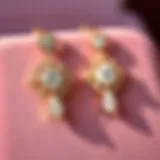Where to Sell Your Lab-Grown Diamond: A Comprehensive Guide
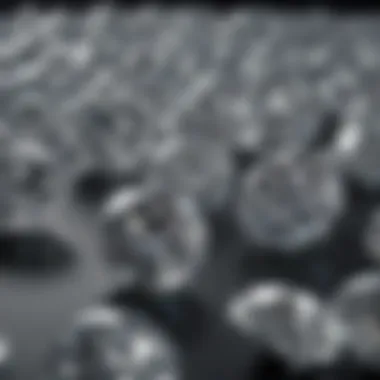

Intro
The ascent of lab grown diamonds in the gemstone market emerges from both technological innovation and changing consumer preferences. Unlike their natural counterparts, which take millions of years to form, lab-grown diamonds create a bridge between the realms of science and fashion. With buyers now increasingly opting for ethical and sustainable alternatives, the allure of lab grown diamonds continues to expand. Many owners of these diamonds may reach a juncture where they contemplate selling. Therefore, understanding where to sell your lab grown diamond is crucial.
In this article, we shall explore the various avenues available for selling lab-grown diamonds. From well-established online platforms to local retailers, as well as more direct sales options, each method brings forth unique considerations. It is essential to identify your specific needs and understand how various factors will impact the process, including market dynamics and financial outcomes.
Overview of Gemstones and Minerals
History of Gemstone and Mineral Use
Throughout history, gemstones and minerals have held significant value, resonating within various cultures. Historically, societies have utilized gemstones not only for their aesthetic charm but also for purported metaphysical properties. From the ancient Egyptians decorating tombs with semi-precious stones to modern jewelry artistry, the human connection with these natural wonders remains profound.
Significance in Culture and Society
The relevance of gemstones extends beyond physical allure. Various cultures believe in the unique properties attributed to specific stones. For instance, diamonds symbolize eternal love in many cultures, leading them to be central in engagement rituals. Understanding the cultural significance ultimately reflects the reason behind the ongoing demand and desire to own or sell gemstones including lab-grown diamonds.
Gemstone Formation and Properties
Formation Process of Gemstones
Understanding how gemstones form provides essential context when discussing their sale. Natural diamonds develop under intense pressure and temperature deep within the earth.
Conversely, lab-grown diamonds replicate this environment in controlled settings using methods such as High-Pressure High Temperature and Chemical Vapor Deposition. As a result, their inherent chemical structure mirrors that of natural diamonds, providing appealing factors when selling.
Properties that Define Gemstones
Three primary factors categorize gemstones: clarity, color, and cut. Clarity refers to the presence of inclusions or blemishes found within the stone. Color signifies the visual hue of the stone, while cut determines how light enters inside the diamond. Each of these properties plays a pivotal role in determining the value of the gemstone, ultimately affecting pricing during sales.
Identifying and Evaluating Gemstones
Factors Affecting Gemstone Value
Various elements interact to determine the worth of a lab-grown diamond. These can include:
- Carat weight
- Quality of cut
- Clarity grade
- Color grade
Taking the time to understand these factors is vital for anyone looking to sell their diamond successfully.
Techniques for Gemstone Identification
Identifying lab-grown diamonds efficiently often requires professional evaluations. Certifications from organizations such as the Gemological Institute of America (GIA) provide trustworthy documentation aiding in identification and increase potential buyer confidence.
Caring for Gemstones
Cleaning and Storing Gemstones Properly
Proper care of your lab-grown diamond cannot be underestimated. Regular cleaning enhances its sparkle. A mixture of mild soap and water with a soft brush works wonders. Equally, storing the diamond in a fabric-lined jewelry box prevents scratches.
Such measures not only preserve value but overall condition, making the stone even more desirable when deciding to sell.### Avoiding Common Mistakes in Gemstone Care
Sellers should be aware of common mistakes in gemstone storage or maintenance. Certain chemical cleaners can compromise the diamond’s quality and should always be avoided.
Overall, taking these small considerate steps will ultimately lead to enhancing the experience of selling rather than hassle.
The End
Selling lab-grown diamonds encompasses knowing where to list them, understanding their value, and taking care of them before the sale. Each dimension plays a huge role in maximizing financial outcome and ensuring a satisfactory experience. Planning carefully castles success and tapping into the healthily growing market.
The lab-grown diamond market growing signifies shifting consumer preferences.
By applying careful considerations, you can trade your gem efficiently in today's rapidly evolving market.
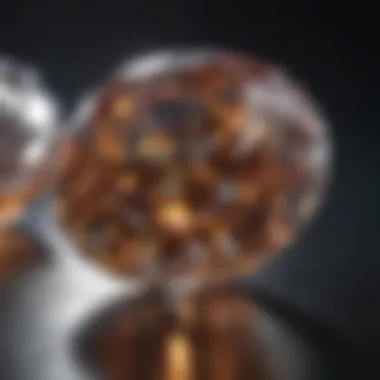

Understanding Lab Grown Diamonds
Understanding lab grown diamonds is an essential step in the process of selling these gemstones. Lab grown diamonds represent both a novel source of value and a changing paradigm in the jewelry and gemstone sectors. They are made using technology that replicates the natural conditions under which diamonds are formed. This technological precision leads to stones that often match or surpass the quality of their natural counterparts.
By understanding lab grown diamonds, sellers can make more informed decisions about their options. This knowledge helps to frame discussions around their value, market potential, and features that may appeal to specific buyers.
Definition and Characteristics
Lab grown diamonds are diamonds that have been created using man-made processes, typically in high-pressure or high-temperature environments. They exhibit the same chemical composition and physical properties as natural diamonds, consisting of carbon atoms arranged in a crystalline structure.
The primary characteristics that distinguish lab grown diamonds include:
- Chemical and Optical Similarity: They are chemically the same as natural diamonds.
- Grading: Lab grown diamonds are graded by the same standards relevant to natural stones (the 4Cs: cut, color, clarity, carat).
- Inclusions: Some lab grown diamonds might contain features that help gemologists discern their origin through advanced imaging techniques.
Knowing these characteristics is crucial for sellers as it impacts how they market their stones and communicate their value proposition to potential buyers.
Comparison with Natural Diamonds
The distinction between lab grown diamonds and natural diamonds is significant. Buyers often have strong preferences based on several factors:
- Authenticity: While lab grown diamonds are real diamonds, some consumers prefer natural diamonds due to their traditional association with rarity and natural occurrence.
- Pricing: Generally, lab grown diamonds tend to be less expensive than their natural counterparts. Sellers need to be aware of these price differences to set competitive offerings.
- Ethical Considerations: For many, lab grown diamonds offer an alternative free from the unethical mining practices sometimes associated with natural diamonds. This ethical element can increase their appeal.
The ongoing conversation about sustainability and ethics will continue to influence how these diamonds are perceived and valued in the marketplace.
Market Demand and Growth Trends
Recent years have seen exponential growth in the demand for lab grown diamonds. Factors aiding this trend include advancements in technology, shifting consumer preferences, and broader acceptance within the jewelry market.
- Younger Consumers: Many millennials and Gen Z shoppers are more open to lab grown stones. They often prioritize price, sustainability, and the environmentally friendly aspects during their purchasing decision.
- Investment Potential: Despite not having the same historical appreciation as natural diamonds, many are beginning to view lab grown diamonds as potential investment avenues.
- Future Outlook: Market projections suggest continued growth, indicating that lab grown diamonds are here to stay. Industry insiders predict offerings will diversify, appealing to a wider audience.
Understanding market demand and growth trends is pivotal for sellers, as this insight can direct their selling strategies, marketing efforts, and potential pricing approaches.
"A comprehensive grasp of your product can significantly enhance your negotiating position in any selling scenario."
Evaluating Your Lab Grown Diamond
Evaluating your lab-grown diamond is an important step before selling. It can directly influence how much you can expect to receive. Knowledge about quality and value is vital to make informed decisions regarding your selling methods. It ensures that you do not undervalue your stone or make ill-informed promises to prospective buyers. When you understand what makes your diamond unique, you can approach buyers with confidence and clarity.
Assessing Quality and Value
Understanding the 4Cs
The 4Cs refer to Carat weight, Cut, Color, and Clarity. This framework serves as a benchmark for diamond quality. Each 'C' significantly influences the appeal and value of the stone.
Carat weight refers to the size of the diamond. Larger diamonds are rarer, and thus, generally command higher prices.
Cut assesses how well the diamond has been shaped and faceted. A superior cut maximizes its brilliance, making it visually appealing.
Color grades the whiteness of the diamond, with less color usually indicating higher quality.
Clarity evaluates the presence of imperfections within or on the surface of the diamond. Fewer inclusions mean a clearer diamond and higher grade.
For those looking to sell, having a clear grasp of the 4Cs allows better positioning in transactions. Understanding its qualities adds allure and increases value.
Impact of Certification
Certification offers a formal assessment of the diamond based on is its characteristics including the 4Cs. Generally, laboratories like the Gemological Institute of America (GIA) and the International Gemological Institute (IGI) issue certifications. A valued diamond typically comes with a reputable certificate that enhances marketability.
When the diamond is from a recognized certifying organizations, potential buyers feel more secure in their purchase. This buyers' trust often translates into a higher selling price. A reputable certification ensures deeper insight into quality, thus alleviating doubts.
While obtaining certification add to initial costs, the benefits in selling higher potential fees can outweigh this. Recognizing its impact enables you to navigate pricing more effectively.
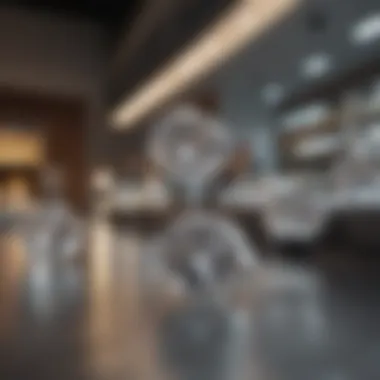

Establishing a Fair Price
Establishing a fair price rests upon gathering accurate market data. Resources often used to ascertain value include online marketplaces and gem appraisal services. By comparing similar listings from platforms like eBay or specialized gem dealers, sellers gather reference points. Insights into current trending prices strongly influence how a diamond can be fairly priced.
Consider further evaluating timing and market dynamics; consumer interest can fluctuate seasonally or based on economic conditions. Establishing a fair price can involve a mix between knowing your diamond's unique characteristics and the current market trends.
Online Selling Platforms
Online selling platforms have proven crucial in the lab-grown diamond market. The rise of e-commerce in recent years has accelerated the ease of buying and selling goods. For individuals looking to offload a lab-grown diamond, these platforms offer geographic and audience advantages that a brick-and-mortar store cannot. They allow sellers to reach a broader customer base and provide flexibility in how they display and price their gems. However, sellers must also consider fees and the level of competition when using these platforms.
E-commerce Websites
Marketplaces like eBay and Amazon
Marketplaces like eBay and Amazon have established their significance as premier online selling venues due to their massive user bases. This broad reach is potentially appealing for lab-grown diamond sellers. A seller might benefit greatly from the sheer volume of potential buyers. Listing a diamond on these platforms maximizes exposure, providing the possability of a quicker sale.
The main characteristic is immediate access to a global market. Unlike specialized sites, these marketplaces deal in various products, broadening potential seller engagement. Listings can include detailed descriptions and images, giving consumers a clear idea of what they are purchasing.
However, both eBay and Amazon charge various seller fees which could erode profits. A seller must account for the cost of listing, final valuation, and potentially shipping. The high volume of diamonds on eBay and Amazon might complicate finding a buyer willing to pay a desirable price. Sellers who choose this route should focus on presenting their diamond through well-prepared listings that highlight unique qualities.
Specialized Gem Selling Sites
Specialized gem selling sites have emerged to cater specifically to buyers and sellers of fine gemstones. Sites designed explicitly for gems allow sellers to reach a target audience focused on jewelry and diamonds. These sites understand the nuances of the diamond market. It may lead to selling at a fair price without competing directly with non-gem products.
An essential feature of these specialized platforms is the tenet of trust. They often require certifications or use reputable authentication methods to reassure buyers about the diamond's quality. Sellers lead to building more significant bargaining leverage compared to general marketplaces.
On the downside, sellers on specialized sites may face higher transaction fees or longer waiting times to build interest around their listings. Finding success here requires patience and careful marketing efforts to maximize visibility. Nonetheless, for quality gems, these platforms provide solid advantages that can enhance financial outcomes for sellers.
Jewelry Auction Websites
Jewelry auction websites have become an exciting avenue for selling lab-grown diamonds. These sites provide unique opportunities to auction jewelry to engaged buyers. Through live bidding or timed events, sellers can establish a transparent sales environment that encourages competitive bidding. Eventually, reaching prices that reflect the true value of lab-grown diamonds can lead to satisfying sales.
Sellers might find it necessary to have appraisal documents or other protective measures in place when using auction websites. Knowledge of timing and promotion can greatly alleviate potential obstacles in the auction process. As auction networks vary in reputation and operation, individuals should research thoroughly to select a reliable platform for successful sales.
Social Media Marketplaces
Social media marketplaces, such as those integrated into platforms like Facebook, have also become popular. Listing a lab-grown diamond directly through social media taps into existing networks. Sellers can showcase their diamond by posting on various community pages dedicated to jewelry sales. The peer-centric nature of these platforms offers buyers comfort from perceived social endorsement that helps drive down price negotiations.
However, there are risks associated with selling through social media. First, users may come across scams, making it essential for sellers to do their due diligence on potential buyers. Second, reaching individual buyers through posts may require frequent engagement to maintain visibility. Despite this, social media marketplaces create community-driven interactions that can nurture relationships and lasting sales agreements.
Physical Retail Options
Physical retail options offer tangible benefits for selling lab-grown diamonds. Many sellers prefer this method due to its personal interactions and reassurance compared to virtual platforms. Engaging face-to-face can establish trust, which is often crucial in higher-value transactions. In addition, local and community-focused transactions may attract buyers who appreciate seeing the product in person before making a purchase.
Local Jewelry Stores
Consignment Sales
Consignment sales present a unique method for selling a lab-grown diamond. In this arrangement, the seller leaves the diamond in a local jewelry store, and the store sells it on the seller's behalf. The key characteristic of consignment selling lies in the shared risk; only when the diamond is sold does the store take a commission. This method is beneficial because it enables sellers to leverage the store's existing customer base without upfront fees.
However, there are some considerations with consignment sales. The unique feature of this selling option is the potential for immersive exposure; customers regularly visit jewelry stores to browse. A disadvantage can include waiting time, as the diamond may not sell quickly. Personalized service may also depend on the individual seller's effort in marketing through the store's resources.
Trade-In Opportunities
Trade-in opportunities also serve as a viable option for individuals wishing to sell their lab-grown diamonds. This method often involves exchanging the diamond for credit toward a new purchase within the same store. An important key characteristic is the ease of transition; customers seeking new jewelry can enjoy the convenience of trading their existing piece at the same location.
This approach is attractive because it streamlines the sales process when customers wish to upgrade or modify their jewelry collection. The unique feature observed is the instant gratification from receiving credit on a new item rather than waiting for the diamond to sell independently. Nonetheless, one disadvantage is that the trade-in prices may not reach full market value, which could be a point of consideration for sellers, especially those looking to maximize their return.
Gem and Jewelry Shows
Gem and jewelry shows represent another dynamic outlet for selling lab-grown diamonds. These events often assemble buyers and sellers in a concentrated environment, offering various networking opportunities. The idea is to showcase your diamond in a setting specifically geared toward enthusiasts and professionals who appreciate the craftsmanship and qualities of jewerly.
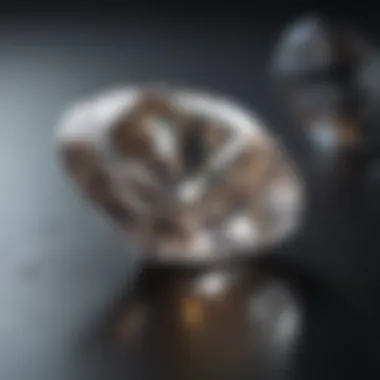

The experience of being present at these shows can provide immediate feedback and market insights. These aspects combine to make gem shows a comprehensively strategic place to engage with potentially interested buyers. A seller can demonstrate their knowledge and passion for their diamond, again enhancing the total sales experience through personal interaction. সব ব্যক্তিগত উল্লেখ চাইলে এক রহস�্য কাজের সংলাপ আকর্ষণীয় হবে।
Direct Selling Methods
Direct selling methods present alternatives to traditional retail selling for lab grown diamond owners who prefer more control, direct interaction, and potentially higher profits. They allow sellers to bypass intermediaries and connect directly with end buyers. This method might appeal to those who intimate their diamonds and want to prioritize personal engagement when selling.
Private Sales
Networking with Buyers
Networking with buyers is a crucial element of private sales. This approach involves building relationships or tapping into personal contacts to find those interested in purchasing your diamond. What makes this method appealing is the personal touch it adds. Buyers may be more at ease purchasing from someone they know or can meet face-to-face, fostering trust and transparency in the transaction.
An important characteristic of networking is the ability to access niche markets, which can lead to competitive offers. Flawlessly navigating your own social or professional circle could yield buyers who appreciate the uniqueness of lab-grown diamonds and understand their value. Networking can happen during social events, at community gatherings, or in specialized groups related to interests in gemstones.
However, while this method provides benefits such as reduced commission fees and ease of communication, it can also present challenges. The unique downside is that potential buyers may be limited to your immediate circle, or the quality of offers can vary based on interest and engagement within your network.
Utilizing Online Forums
Utilizing online forums represents a direct selling avenue that can lead to worldwide exposure. Many websites allow users to buy, sell, and discuss lab-grown diamonds, connecting sellers with an interested audience who regularly visits these platforms. Quite favored, online forums serve as both a marketplace and an information hub. The candid feedback you get can foster better negotiations, enriching the selling experience.
The key characteristic of these online forums is their democratized, global nature. They do not limit you to your local environment and can significantly widen your reach as a seller. Through discussions and interactions, forum users can gain insights, validate pricing strategies, and identify prospective buyers.
A unique feature of using online forums is their variety. Not all forums cater to the same audience; there are specific communities for gemstones, which means you might engage with enthusiasts who increasing offer competitive rates for your diamond. Nonetheless, there are disadvantages too. Some potential buyers may remain wary of online transactions. Escrow services or secure payment methods need to be taken into account to enhance transaction security.
Word of Mouth and Referrals
Word of mouth is another considerable aspect of selling lab-grown diamonds. It relies heavily on personal recommendations from friends, family, or acquaintances. When someone can personally validate the value or experience of a seller, it often amplifies the chances of a successful sale. Referrals, whether through casual acquaintances or formal introductions, can substantially broaden potential buyers. Sellers can create a simple incentive for recommendations, further enhancing their outreach.
In essence, leveraging social circles results in reduced marketing costs while gaining impressive credibility. Most people trust personal recommendations, making word of mouth one of the most powerful marketing methods.
While the method could work brilliantly, you may find some limitations too. Not everyone in your circle may be actively looking to purchase diamonds, so relying solely on this method could slow down the sales process if individuals' interests do not align.
Considerations Before Selling
Before selling your lab-grown diamond, it is crucial to evaluate certain considerations. These elements can influence not only the financial return but also the ease and success of the selling process. Understanding these important considerations can enhance your decision-making strategy.
Legal and Ethical Considerations
When selling a lab-grown diamond, it is imperative to know the legal backdrop surrounding the sale. Laws about precious stones can vary significantly by region. In many countries, there are regulations on gem certification, grading and disclosure of the diamond's nature. Failing to comply with these legal divergences could lead to intentions regarding unintentional misrepresentation.
If your diamond is certified, including relevant documentation can boost buyer confidence. Ethical considerations also play a key role. Be clear and honest about the goods being sold, specifically disclosing that the diamond is lab-grown. The demand for ethically sourced diamonds is increasing, so honesty in this aspect can enrich your selling power and reputability. Moreover, transparent selling practices embrace community responsibility and social awareness, enhancing the buying experience for your customers.
Market Timing and Economic Factors
Analyzing market timing and economic elements is vital when you enter the gemstone marketplace. Abrupt shifts in demand or economic downturns impact prices substantially. Take the time to research current market trends surrounding lab-grown diamonds, which frequently presents itself as more volatile than natural stones.
Carefully tracking the price index for lab-grown diamonds allows you to pinpoint the best periods for selling. Online platforms and jewelry marketplaces usually show price fluctuations that can guide your timing decisions. Additional factors affecting the market include consumer preference and seasonal buying patterns; many consider Holidays or special occasions—like engagements—prime times for sales.
To maximize returns, keep a close lookout on economics and consumer interest. Resales generally follow trends, making it logistically stategic to time your sale around high-demand periods.
"Understanding legal and ethical dynamics along with market timing significantly contributes to informed decisions when selling your lab-grown diamond."
Navigating both legalities and market timings aids in streamlining the resale plan. When employing diligent research and full awareness of the industry's ebb and flow, sellers can enhance their opportunity for success.
Ending
In the context of this article, understanding how to sell lab-grown diamonds is crucial. With the increasing market acceptance of these gems, sellers must be informed about their options and the potential outcomes involved. It is not merely about finding a buyer; it also concerns the approach taken when marketing these stones, particularly with regard to the perceived value.
The information covered underscores the importance of a multi-faceted strategy. Knowledge of different selling methods—whether it’s through e-commerce sites, local jewelers, or private sales—not only influences the sale price but also affects the speed and ease of the transaction. Each avenue presents unique advantages and challenges that sellers must navigate.
Making Informed Decisions
By leveraging the insights discussed, sellers can evaluate their circumstances more effectively. Every diamond is unique, and the sentiment attached to it further complicates the decision. To make an informed choice, several factors warrant consideration:
- Market Trends: Always research current trends in the lab-grown diamond market. Prices, demand, and preferences can fluctuate, impacting your sale potential.
- Quality Assessment: Be clear about the quality and characteristics of your diamond, exemplified by understanding the 4Cs—Cut, Color, Clarity, and Carat weight. Gems that are well-evaluated often attract more buyers.
- Selling Method Preferences: Different methods appeal to different types of sellers. Understanding desired outcomes and whether speed or maximum profit is priority can streamline your choice.
- Legal and Ethical Preparation: It's essential to prepare any documentation to prove the diamond's authenticity. Shoppers are likely to appreciate transparency, increasing their confidence in the transaction.
Being methodical during the selling process and having the relevant information will not only help maximize financial outcomes, but it will also shape perceptions of characteristics that matter most to potential buyers. In essence, informed decision-making acts as the cornerstone of making successful sales in today's growing market for lab-grown diamonds.
Informed decisions result in optimized outcomes, aligning seller motivations with buyer expectations.
